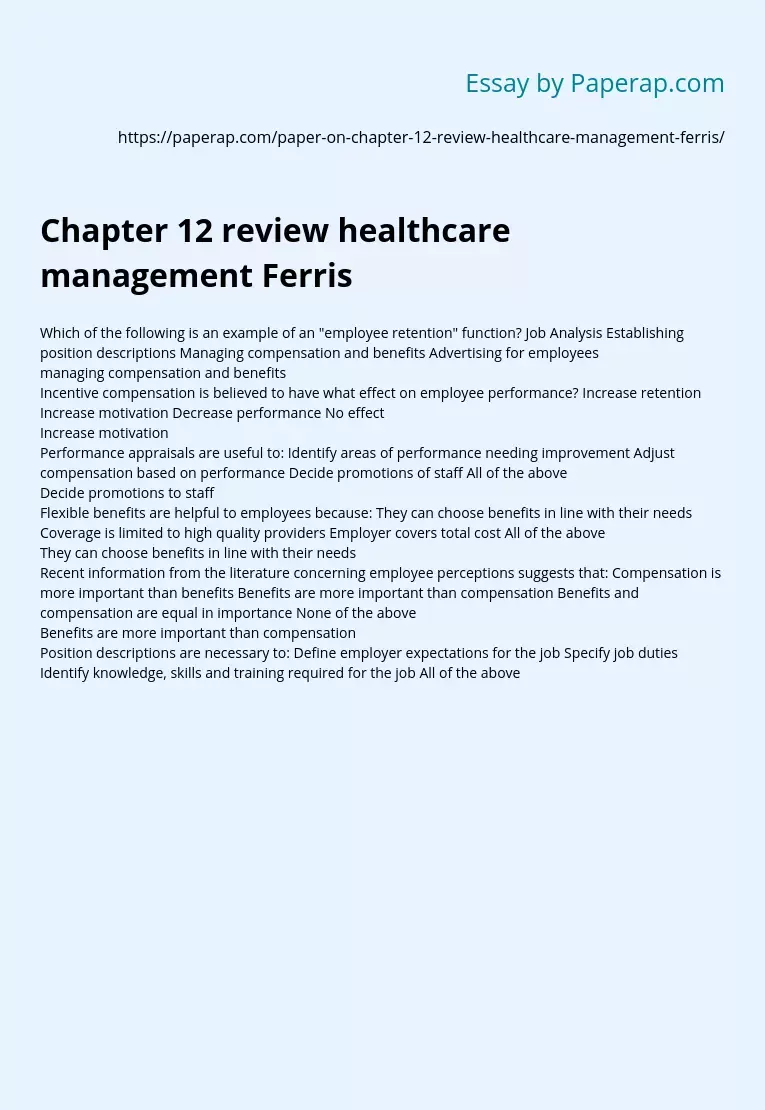Chapter 12 review healthcare management Ferris
Topics:
Economics
Review,
Pages 2 (498 words)
Views
122
Which of the following is an example of an “employee retention” function?
Job Analysis
Establishing position descriptions
Managing compensation and benefits
Advertising for employees
Job Analysis
Establishing position descriptions
Managing compensation and benefits
Advertising for employees
managing compensation and benefits
Incentive compensation is believed to have what effect on employee performance?
Increase retention
Increase motivation
Decrease performance
No effect
Increase retention
Increase motivation
Decrease performance
No effect
Increase motivation
Performance appraisals are useful to:
Identify areas of performance needing improvement
Adjust compensation based on performance
Decide promotions of staff
All of the above
Identify areas of performance needing improvement
Adjust compensation based on performance
Decide promotions of staff
All of the above
Decide promotions to staff
Flexible benefits are helpful to employees because:
They can choose benefits in line with their needs
Coverage is limited to high quality providers
Employer covers total cost
All of the above
They can choose benefits in line with their needs
Coverage is limited to high quality providers
Employer covers total cost
All of the above
They can choose benefits in line with their needs
Recent information from the literature concerning employee perceptions suggests that:
Compensation is more important than benefits
Benefits are more important than compensation
Benefits and compensation are equal in importance
None of the above
Compensation is more important than benefits
Benefits are more important than compensation
Benefits and compensation are equal in importance
None of the above
Benefits are more important than compensation
Position descriptions are necessary to:
Define employer expectations for the job
Specify job duties
Identify knowledge, skills and training required for the job
All of the above
Define employer expectations for the job
Specify job duties
Identify knowledge, skills and training required for the job
All of the above
All of the above
Human resources decisions need to be strategic because of:
Increasing competition among HSOs
The need to analyze jobs
Trends in using incentive compensation
All of the above
Increasing competition among HSOs
The need to analyze jobs
Trends in using incentive compensation
All of the above
Increasing competition among HSOs
Major federal law affecting human resources primarily addresses:
Protections for applicants and rights of employees
Safety of the workplace
Accommodations for people with disabilities
All of the above
Protections for applicants and rights of employees
Safety of the workplace
Accommodations for people with disabilities
All of the above
Protection for applicants and rights employees
Employee Assistance Programs address:
Incentive compensation for employees
Employee problems
Retirement plans
All of the above
Incentive compensation for employees
Employee problems
Retirement plans
All of the above
Employee problems
Employee Suggestion Programs:
Usually do not reward top suggestions
Are viewed by employees as positive because of the opportunity to have input
Are the same as Employee Assistance Programs
None of the above
Usually do not reward top suggestions
Are viewed by employees as positive because of the opportunity to have input
Are the same as Employee Assistance Programs
None of the above
Are viewed by employees as positive because of the opportunity to have input
The National Labor Relations Board provides guidance for HR in addressing:
Unions and collective bargaining
Employee retirement plans
Recruitment
Equal Opportunity
Unions and collective bargaining
Employee retirement plans
Recruitment
Equal Opportunity
Unions and collective bargaining
The best way for management in HSOs to avoid unions is to:
Foster positive communication with employees
Encourage feedback from employees
Show interest in and meet the needs of employees
All of the above
Foster positive communication with employees
Encourage feedback from employees
Show interest in and meet the needs of employees
All of the above
All of the above
“Benefits” include all of the following except:
Retirement Plan
Vacation
Health Insurance
Salary
Retirement Plan
Vacation
Health Insurance
Salary
Salary
Staff shortages can lead to:
Dissatisfied staff
Staff turnover
Longer work hours for staff
All of the above
Dissatisfied staff
Staff turnover
Longer work hours for staff
All of the above
All of the above
The perspective that HSO employees should be viewed as a strategic asset means:
Organizational performance is based on individuals
Staff salaries and benefits are costly and affect the HSO’s competitiveness
Staff should be used in multiple roles to create flexibility
Staff should report to only one manager
Organizational performance is based on individuals
Staff salaries and benefits are costly and affect the HSO’s competitiveness
Staff should be used in multiple roles to create flexibility
Staff should report to only one manager
Organizational performace is based on indivisuals
Which of the following is an example of a HSO’s Employee Relations and Engagement efforts?
“Walk-arounds” by managers
Job analysis
Job pricing
Assessing an employee’s job performance
“Walk-arounds” by managers
Job analysis
Job pricing
Assessing an employee’s job performance
“Walk-around” by managers
Chapter 12 review healthcare management Ferris. (2018, Jan 22). Retrieved from https://paperap.com/paper-on-chapter-12-review-healthcare-management-ferris/
